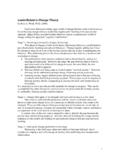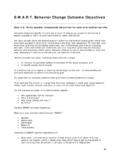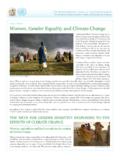Transcription of Confident. Connected. Open to Change. - Pew …
1 PewResearchCenter MILLENNIALS. A Portrait of Generation Next Confident. Connected. Open to change . February 2010. pew research Center is a nonpartisan fact tank that provides information on the issues, attitudes and trends shaping America and the world. It does so by conducting public opinion polling and social science research , by analyzing news coverage, and by holding forums and briefings. It does not take positions on policy issues. Its work is carried out by seven projects: pew research Center for the People & the Press pew research Center's Project for Excellence in Journalism Pew Internet & American Life Project Pew Forum on Religion & Public Life Pew Hispanic Center Pew Global Attitudes Project Pew Social & Demographic Trends Project It provides its research and data free of charge as a public service to policymakers, researchers, journalists and the general public.
2 All publications and datasets can be accessed via , which is a portal to a network of pew research websites. PewResearchCenter Millennials Confident. Connected. Open to change . This publication is part of a pew research Center report series that looks at the values, attitudes and experiences of America's next generation: the Millennials. Find out how today's teens and twentysomethings are reshaping the nation at: Preface This report represents the pew research Center's most ambitious examination to date of America's newest generation, the Millennials, many of whom have now crossed into adulthood. We began looking at this age group in 2006 in a comprehensive survey we conducted in association with the PBS documentary series, Generation Next.. Our new report greatly expands on that seminal work. In the pages that follow we set out to compare the values, attitudes and behaviors of Millennials with those of today's older adults.
3 And to the extent that we can, we also compare them with older adults back when they were the age that Millennials are now. But we undertake this exercise in generational portraiture with a healthy dose of humility. We know that, in one sense, it's too easy and in another, it's too hard. It's too easy because most readers don't need a team of researchers to tell them that the typical 20-year-old, 45- year-old and 70-year-old are likely to be different from one another. People already know that. It's too difficult because, try as we might, we know we can never completely disentangle the multiple reasons that generations differ. At any given moment in time, age group differences can be the result of three overlapping processes: 1) Life cycle effects. Young people may be different from older people today, but they may well become more like them tomorrow, once they themselves age.
4 2) Period effects. Major events (wars; social movements; economic downturns; medical, scientific or technological breakthroughs) affect all age groups simultaneously, but the degree of impact may differ according to where people are located in the life cycle. 3) Cohort effects. Period events and trends often leave a particularly deep impression on young adults because they are still developing their core values; these imprints stay with them as they move through their life cycle. It's not always possible to identify much less unpack and analyze these various processes. On many measures, the long-term trend data needed to make comparisons simply do not exist. Also, while generations may have personalities, they are not monolithic. There are as many differences within generations as there are among generations. Moreover, the composition of a given age cohort can change over time as result of demographic factors such as immigration and differential mortality.
5 Finally, even if we had a full set of long-term data, we know that the discrete effects of life cycle, cohort and period cannot be statistically separated from one another with absolute certainty. Nonetheless, we believe this journey is worth taking. All of us know people who still bear the marks of their distinctive coming-of-age experiences: the grandmother raised during the Depression who reuses her tea bags;. the child of the Cold War who favors an assertive national security policy; the uncle who grew up in the 1960s and sports a pony tail. We don't yet know which formative experiences the Millennials will carry forward throughout their life cycle. But we hope that the findings presented here begin to shine a light on what they are like today and on what America might be like tomorrow. Paul Taylor and Scott Keeter, editors Table of Contents About the Report.
6 I 1 1. 2 9. 3 Identity, Priorities, Outlook ..13. 4 Technology and Social Media ..25. 5 Work and Education ..39. 6 Family Values ..51. 7 8 Politics, Ideology and Civic Engagement ..63. 9 Religious Beliefs and Behaviors ..85. Appendices Survey Methodology ..110. Topline questionnaire ..113. i About the Report This report on the values, attitudes, behaviors and demographic characteristics of the Millennial generation was prepared by the pew research Center, a nonpartisan fact tank that provides information on the issues, attitudes and trends shaping America and the world. The Center does not take positions on policy issues. Findings in this study are mainly based on the results of a telephone survey conducted Jan. 14 to 27, 2010, on landlines and cell phones with a nationally representative sample of 2,020 adults. To allow for a detailed analysis of attitudes of the Millennial generation, the survey includes an oversample of respondents ages 18 to 29, for a total of 830 respondents in this age group.
7 The margin of error due to sampling is plus or minus 3 percentage points for the full sample and plus or minus 4 percentage points for the sample of Millennials. Interviews were conducted in English or Spanish. The survey field work was carried out by Abt SRBI Inc. For a full description of the research methodology, see page 110. A note on terminology used in this report: Whites include only non- Hispanic whites. Blacks include only non-Hispanic blacks. Hispanics are of any race. Data from this 2010 survey were supplemented by findings from many other pew research Center surveys, including two relatively recent ones: a survey on changing attitudes toward work conducted Oct. 21-25, 2009, with a nationally representative sample of 1,028 respondents ages 18 and older and a survey on generational differences conducted July 20-Aug. 2, 2009, with a nationally representative sample of 1,815 people ages 16.
8 And The chapter on demography (Chapter 2) is based on a pew research Center analysis of census data. The chapter on technology (Chapter 4) draws on the 2010 survey as well as on surveys conducted over the years by the pew research Center's Internet & American Life Project. The chapter on political ideology and engagement (Chapter 8) is based on data from the 2010 survey as well as on our analysis of more than 20 years of data from polls on political and social values conducted by the pew research Center for the People & the Press. The chapter on religious beliefs and behaviors (Chapter 9) draws on surveys conducted over the years by the pew research Center's Forum on Religion & Public Life, the General Social Survey and the Gallup organization. The following people at the Center carried out this project: Andrew Kohut, President Paul Taylor, Executive Vice President Scott Keeter, Director of Survey research Kim Parker, Senior Researcher Rich Morin, Senior Editor D'Vera Cohn, Senior Writer Mark Hugo Lopez, Senior Researcher Gregory Smith, Senior Researcher Richard Fry, Senior Researcher 1.
9 To view the report summarizing the results of the work survey, go to The report on generational differences is at ii Wendy Wang, research Associate Leah Melani Christian, research Associate Allison Pond, research Associate Scott Clement, research Analyst Others at the Center who contributed to this report include: Jodie Allen, Alan Cooperman, Michael Dimock, Daniel Dockterman, Carroll Doherty, Elizabeth Mueller Gross, Russell Heimlich, Juliana Menasce Horowitz, Michael Keegan, Jocelyn Kiley, Rakesh Kochhar, Vidya Krishnamurthy, Amanda Lenhart, Gretchen Livingston, Luis Lugo, Mary Madden, Tracy Miller, Robert Mills, Shawn Neidorf, Alicia Parlapiano, Jeffrey Passel, Michael Piccorossi, Jacob Poushter, Lee Rainie, Hilary Ramp, Michael Remez, Rob Suls, Tom Rosenstiel, Mary Schultz, Kathleen Holzwart Sprehe, Sandra Stencel, Alec Tyson, Gabriel Velasco and Diana Yoo.
10 Chapter 1: Overview 1. Chapter 1: Overview Generations, like people, have personalities, and Millennials the American teens and twenty-somethings who are making the passage into adulthood at the start of a new millennium have begun to forge theirs: confident, self-expressive, liberal, upbeat and open to change . They are more ethnically and racially diverse than older The New Face of America adults. They're less religious, Millennials (ages 18-29) Adults ages 30 and older less likely to have served in the military, and are on track to Black Black become the most educated 14% 11%. generation in American Hispanic Hispanic 13%. history. 19%. 5% Asian Their entry into careers and 61%. 5% Other first jobs has been badly set Asian 70%. back by the Great Recession, White Other White but they are more upbeat than their elders about their own Source: December 2009 Current Population Survey (CPS).





